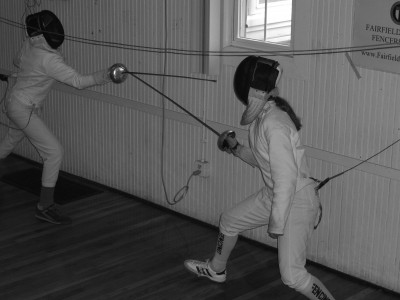 The term “sword fighting” conjures images of knights in shining armor and dangerous conquests that only Prince Charming can defeat. But to Tessa Schroll ’13, swordplay is just another day’s work.
The term “sword fighting” conjures images of knights in shining armor and dangerous conquests that only Prince Charming can defeat. But to Tessa Schroll ’13, swordplay is just another day’s work.
“It’s not just throwing a sword at somebody like most people think,” Schroll said. “Fencing is so much more complicated.”
Schroll began fencing at the YMCA in 2007. Since then, she has relocated to the Candlewood Fencing Center where she and Cole De Monico ’13 currently fence.
“[Fencing] requires a lot of thinking about actions and responses on the fly,” De Monico said. “Some fencers like to liken it to physical chess, which is a pretty fitting description.”
According to De Monico, “physical chess” requires a lot of hard work. On the three days each week that he fences, De Monico says the workout consists of suicide-style sprints, intensive stretching, squat-thrusts, lunges, footwork practice, and other assorted leg exercises. It’s no walk in the park.
“It’s crazy at tournaments. There can be 50 people there and at the end it boils down to two,” Schroll said.
A normal bout of fencing is carried out on a sectioned off strip, usually five feet wide. Matches last for either five, seven, or 10 points and the rules vary for what style of fencing is being played: foil, sabre, or epee.
Points are scored by what in fencing is called a “flick,” which in essence is hitting the opponent by a whip of the blade. In foil, the tip of the blade is blunt while in epee and sabre the blade is thick and results in quicker action rather than intricate tactics.
However, one mainstay in all forms of fencing is the high price.
“The blade is usually $200, the mask is usually $100, and the body suit is $150,” Schroll said. “I made the mistake of getting my suit dirty once and I had to get a new one. I hope that never happens again.”
Even though the sport is pricey, what remains true for all fencers is their passion for the game.
“I started fencing at camp one summer and completely fell in love with the sport,” ex-fencer Susan Greenberg ’11 said. “There was something so calculated and precise about all the motions.”
Greenberg fenced competitively for a year and a half and in that span she won an entire circuit and qualified for the Junior Olympics in epee. But even with the accolades, Greenberg found the absence of appreciation for fencing troubling, as do the other fencers.
“It’s really annoying,” Schroll said. “It’s a great sport and I think more people should do it. I really wish it would catch on.”
“I do believe it deserves a bit of respect as it’s a complex, intensive, and old sport,” De Monico said. “When I answer the question ‘what sport do you play?’ the response always varies. I’ve gotten ‘fencing isn’t a sport’ and ‘really? That’s sick’ basically an equal number of times, so I assume most people have basically no idea about it.”
In the future, the three would like to see fencing make it into the FCIACs and get the coverage they think it rightfully deserves.
But for now, they will keep parrying, feinting, lunging, and recovering.
“If fencing came to the FCIACs I’d be the first to join,” Schroll said. “But right now, I’m glad that I can just fence.”
Schroll and De Monico talked earlier this year about starting up a fencing club, however the proposal was rejected due to insurance.
“It makes sense, I guess,” De Monico said. “A lot can go wrong with untrained people swinging metal around.”












































